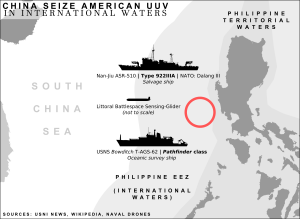Ships vs. UUVs for Mine Clearance - Not Mutually Exclusive
In the July issue of Proceedings (membership required), Royal Navy Commander John Craig argues for the retention of the U.S. Navy's mine countermeasures fleet primarily because unmanned underwater vehicles cannot replace them. CDR Craig certainly has the credentials to comment smartly on this subject, having recently commanded Britain's 2nd Mine Countermeasures Squadron (2MCM).
The U.S. Navy eventually plans to dispose of its MCM ships (the MHC class mine hunters were previously decommissioned in the 2000s) with the Littoral Combat Ship (LCS) embarked with unmanned MCM systems as a planned replacement. Regardless of the wisdom of this decision, unmanned underwater vehicles (UUVs) have been embraced by the U.S. and other modern navies, and are being acquired at a rapid pace. The gradual shift towards unmanned MCM systems is likely a reflection of shrinking defense budgets, but there are probably some operational advantages to be realized as technology and testing advances.
 |
| Bottom mine seen from SeaFox system camera (RN Photo) |
Craig's most compelling argument for retaining MCM ships is that "their greater sonar power increases the volume of water 'hunted' and improves the speed of advance. For classification, the operators who view the sonar picture in real-time can change the frequency of the sonar, allowing more accurate classification of contacts that appear amorphous at first glance."
His argument falls short though when he says that "for prosecution and neutralization, surface ships carry their own ROVs, including spares, and can embark and support an EOD diving team; UUVs cannot." Well of course a small UUV can't do that. But non-dedicated mine-hunting platforms such as the afloat forward staging bases demonstrated during IMCMEX 12 and 13 certainly can do those things and much more. That said, it is not far-fetched to question the wisdom of putting large, metallic-hulled ships anywhere in the vicinity of a mine-field even though these AFSB and the LCS intend to conduct "off-board" MCM with their small boats or unmanned surface vessels launching UUVs from a safe distance.
Another point that CDR Craig didn't make, but probably should have, is that MCM is a complicated operation and dedicated, single-mission crews can develop a proficiency in these operations much higher than the crew of a multi-purpose ship. That issue can be mitigated however, by the use of dedicated special purpose mine-hunting detachments embarked upon the UUV mother-ships, which is the proposed concept for LCS. Technology and fiscal realities may overcome CDR Craig's arguments in modern navies, though clearly, more experimentation is warranted to validate these new concepts.
Interestingly, Crew 1 of 2MCM recently returned from the Persian Gulf where they completed 100 runs with the SeaFox mine disposal system while aboard HMS Atherstone. Replacing explosive ordnance divers and marine mammals with remotely-operated neutralization systems would have been unheard of a few decades ago, but is now commonplace and makes more sense than putting life in danger. So it appears that although the UK is retaining a robust fleet of dedicated mine-hunting vessels, it too increasingly values unmanned MCM systems.
Read more on MCM with UUVs.

Comments
Post a Comment